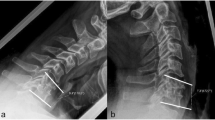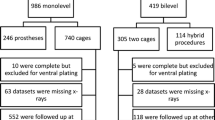Abstract
Purpose
Anterior cervical discectomy and fusion (ACDF) is a common procedure for the treatment of cervical degenerative diseases. However, cage subsidence remains a frequent problem. We therefore investigated if cage design and site-specific bone mineral density (BMD) contribute to the rate and direction of subsidence following ACDF.
Methods
Patients were prospectively included and received two different cages (groups 1 and 2) using minimization randomization. The degree and direction of cage subsidence were determined using plain radiographs. Neck pain intensity on the visual analogue scale (VAS), the neck disability index (NDI), and the patient satisfaction index were recorded up to 12 months after surgery.
Results
88 patients were analysed with a mean age of 53.7 ± 11.8 years. BMD values decreased in craniocaudal direction from 302.0 ± 62.2 to 235.5 ± 38.9 mg/cm3. Both groups showed significant height gain after the operation (both p < 0.001), followed by height loss at 3 months (both p < 0.05) and at 3–12 months after the operation (both p > 0.05). Both groups showed improvement of VAS neck pain intensity (both p < 0.05) and NDI (both p < 0.05). The direction of cage subsidence was similar, no correlations were found between cage subsidence and BMD or various clinical parameters.
Conclusions
Implant geometry of both cages and variations of the operative procedure promoted a relatively high degree of cage subsidence. Further studies are necessary to identify a relation of BMD and subsidence using optimized implant geometry and by controlling additional intraoperative variables.



Similar content being viewed by others
References
Bartels RH, Donk RD, Feuth T (2006) Subsidence of stand-alone cervical carbon fiber cages. Neurosurgery 58:502–508 (discussion 502–508)
Yang JJ, Yu CH, Chang BS, Yeom JS, Lee JH, Lee CK (2011) Subsidence and nonunion after anterior cervical interbody fusion using a stand-alone polyetheretherketone (PEEK) cage. Clin Orthop Surg 3:16–23. doi:10.4055/cios.2011.3.1.16
Kolstad F, Nygaard OP, Andresen H, Leivseth G (2010) Anterior cervical arthrodesis using a “stand alone” cylindrical titanium cage: prospective analysis of radiographic parameters. Spine (Phila Pa 1976) 35:1545–1550. doi:10.1097/BRS.0b013e3181d259c1
Lee CH, Hyun SJ, Kim MJ, Yeom JS, Kim WH, Kim KJ, Jahng TA, Kim HJ, Yoon SH (2013) Comparative analysis of 3 different construct systems for single-level anterior cervical discectomy and fusion: stand-alone cage, iliac graft plus plate augmentation, and cage plus plating. J Spinal Disord Tech 26:112–118. doi:10.1097/BSD.0b013e318274148e
Kast E, Derakhshani S, Bothmann M, Oberle J (2009) Subsidence after anterior cervical inter-body fusion. A randomized prospective clinical trial. Neurosurg Rev 32:207–214 (discussion 214)
Schmieder K, Wolzik-Grossmann M, Pechlivanis I, Engelhardt M, Scholz M, Harders A (2006) Subsidence of the wing titanium cage after anterior cervical interbody fusion: 2-year follow-up study. J Neurosurg Spine 4:447–453. doi:10.3171/spi.2006.4.6.447
Celik SE, Kara A, Celik S (2007) A comparison of changes over time in cervical foraminal height after tricortical iliac graft or polyetheretherketone cage placement following anterior discectomy. J Neurosurg Spine 6:10–16. doi:10.3171/spi.2007.6.1.3
Karikari IO, Jain D, Owens TR, Gottfried O, Hodges TR, Nimjee SM, Bagley CA (2014) Impact of subsidence on clinical outcomes and radiographic fusion rates in anterior cervical discectomy and fusion: a systematic review. J Spinal Disord Tech 27:1–10
Barsa P, Suchomel P (2007) Factors affecting sagittal malalignment due to cage subsidence in standalone cage assisted anterior cervical fusion. Eur Spine J 16:1395–1400
Ordway NR, Lu YM, Zhang X, Cheng CC, Fang H, Fayyazi AH (2007) Correlation of cervical endplate strength with CT measured subchondral bone density. Eur Spine J 22:22
Brenke C, Pott P, Schwarz ML, Schmieder K, Barth M (2014) Development of a low-cost Polymethylmethacrylate (PMMA) stand-alone cervical cage: technical note. J Neurol Surg A Cent Eur Neurosurg 75:317
Weishaupt D, Schweitzer ME, DiCuccio MN, Whitley PE (2001) Relationships of cervical, thoracic, and lumbar bone mineral density by quantitative CT. J Comput Assist Tomogr 25:146–150
Yoganandan N, Pintar FA, Stemper BD, Baisden JL, Aktay R, Shender BS, Paskoff G, Laud P (2006) Trabecular bone density of male human cervical and lumbar vertebrae. Bone 39:336–344
Anderst WJ, Thorhauer ED, Lee JY, Donaldson WF, Kang JD (2011) Cervical spine bone mineral density as a function of vertebral level and anatomic location. Spine J 11:659–667
Oh JK, Kim TY, Lee HS, You NK, Choi GH, Yi S, Ha Y, Kim KN, Yoon DH, Shin HC (2012) Stand-alone cervical cages versus anterior cervical plate in 2-level cervical anterior interbody fusion patients: clinical outcomes and radiologic changes. J Spinal Disord Tech. doi:10.1097/BSD.0b013e31824c7d22
Lim TH, Kwon H, Jeon CH, Kim JG, Sokolowski M, Natarajan R, An HS, Andersson GB (2001) Effect of endplate conditions and bone mineral density on the compressive strength of the graft–endplate interface in anterior cervical spine fusion. Spine 26:951–956
Lowe TG, Hashim S, Wilson LA, O’Brien MF, Smith DA, Diekmann MJ, Trommeter J (2004) A biomechanical study of regional endplate strength and cage morphology as it relates to structural interbody support. Spine (Phila Pa 1976) 29:2389–2394
Hilibrand AS, Carlson GD, Palumbo MA, Jones PK, Bohlman HH (1999) Radiculopathy and myelopathy at segments adjacent to the site of a previous anterior cervical arthrodesis. J Bone Jt Surg Am 81:519–528
Katsuura A, Hukuda S, Saruhashi Y, Mori K (2001) Kyphotic malalignment after anterior cervical fusion is one of the factors promoting the degenerative process in adjacent intervertebral levels. Eur Spine J 10:320–324
Conflict of interest
None.
Author information
Authors and Affiliations
Corresponding author
Rights and permissions
About this article
Cite this article
Brenke, C., Dostal, M., Scharf, J. et al. Influence of cervical bone mineral density on cage subsidence in patients following stand-alone anterior cervical discectomy and fusion. Eur Spine J 24, 2832–2840 (2015). https://doi.org/10.1007/s00586-014-3725-9
Received:
Revised:
Accepted:
Published:
Issue Date:
DOI: https://doi.org/10.1007/s00586-014-3725-9




